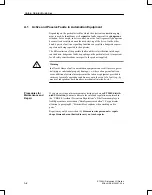
A-2
ET 200U Distributed I/O Station
EWA 4NEB 812 6087–02b
A.1
Active and Passive Faults in Automation Equipment
Depending on the particular task for which the electronic automation equip-
ment is used, both active as well as passive faults can result in a dangerous
situation. For example, in drive control, an active fault is generally dangerous
because it can result in an unauthorized start–up of the drive. On the other
hand, a passive fault in a signalling function can result in a dangerous operat-
ing state not being reported to the operator.
The differentiation of the possible faults and their classification into dange-
rous and non–dangerous faults, depending on the particular task, is important
for all safety considerations in respect to the product supplied.
!
Warning
In all cases where a fault in automation equipment can result in severe perso-
nal injury or substantial property damage, i.e., where a dangerous fault can
occur, additional external measures must be taken or equipment provided to
ensure or force safe operating conditions even in the event of a fault (e.g., by
means of independent limit monitors, mechanical interlocks, etc.).
If you are carrying out measurement or testing work on an ET200U distrib-
uted I/O station, you must adhere to the rules and regulations contained in
the “VBG 4.0 Accident Prevention Regulations” of the German employers
liability assurance association (“Berufsgenossenschaften”). Pay particular
attention to paragraph 8, “Permissible exceptions when working on live
parts.”
Repairs may only be carried out by Siemens service personnel or repair
shops Siemens has authorized to carry out such repairs.
Procedures for
Maintenance and
Repair
Safety–Related Guidelines















































